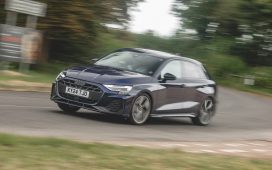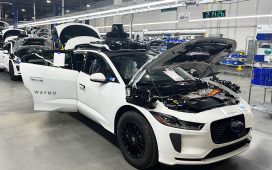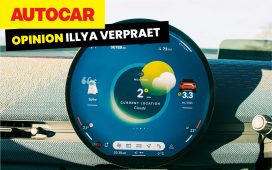The grip is pretty good, though the body rolls through corners which makes the process feel quite dramatic. The brakes are good and the combination of friction linings and regeneration is well mixed, though our test car had a grinding noise when the brakes were applied, which didn’t inspire a lot of confidence.
The pilot system and cruise control might have a load more sensors than anyone else, but they don’t feel particularly advanced. The system doesn’t allow a seamless overtake on the motorway, braking and shunting its way past that truck in the inside lane even if you are indicating. Nor is the steering wheel sensor very sensitive, so you have to periodically waggle the wheel to inform the car you are still there.
On a relatively gentle half day with the car, I saw efficiency of 3.2 miles per kilowatt hour against an official WLTP figure of 3.5. That meant I had a real range of 320 miles against the published 348 miles. It’s not staggeringly efficient then, while using the UK Government’s latest figures, the well-to-wheels CO2 emissions are 36.9g/km.
Verdict
Swappable batteries are interesting technology and seemingly combine the virtues of charging at home or during a journey (at up to 100kW) and also swapping on the move, but they aren’t a panacea.
The battery itself needs a strong and heavy frame. Cell-to-body technologies such as being planned by BMW for next year’s Neue Klasse model will save a lot of weight and in theory will charge more quickly.
But a battery swap system eliminates range anxiety and as one German journalist put it: “Now I can drive with the Porsches and Mercedes in the fast lane without worrying about range, I just get to the next swap station and I’m out as fast as them.”
The ET5 is a bit dull, comfortable, but flawed in places and it seems like a car for wealthy people who need to drive long distances, but don’t like cars very much.
All the same, like BYD with its innovative “blade” batteries, NIO has picked a technology and is committed to introducing it to the world. Mark this company down as one to watch.
The facts
On test: NIO ET5 Touring 100kWh battery swap.
Body style: Battery-electric estate car.
On sale: Estimated 2025 in the UK.
How much? From £54,500 to £72,900 including battery, £44,300 for the battery swap model with £144 to £246 for battery hire.
How fast? Top speed 124mph, 0-60mph in 4.0sec.
Maximum power/torque: 483bhp/516lb ft.
How economical? 3.5m/kWh (WLTP combined), 3.2m/kWh on test.
Electric powertrain: 75kWh LFP and Li-ion NMC cell, or 100kWh li-ion NMC (as tested), twin electric motors with stepdown transmissions, four-wheel drive.
Electric range: 348 miles (WLTP combined), 320 miles on test.
Battery swap time: 4min 37sec.
CO2 emissions: Zero at tailpipe, 36.9g/km (well-to-wheels)
VED: £0.
Warranty: 10 years/unlimited mileage.







